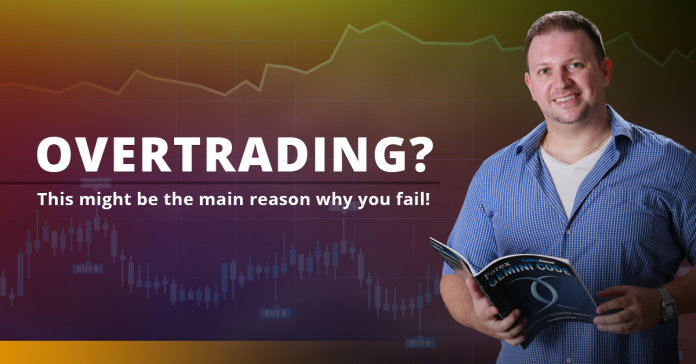
The general concept among traders is the more you trade, the more you will make. It sounds logical but when it comes to the financial markets, it is usually the other way round. Today I will discuss some of the signs of overtrading, what does it do to you and how to avoid it.
Signs of overtrading
One of the most common signs of overtrading is when you jump into a trade BEFORE your strategy has given you the trigger. Just because this candlestick looks like something that we want it to be, it doesn’t mean this is what we will get at the close. Many times there will be stop loss hunting near important levels. The price action seems strong and powerful, only to find out at the end that it was an empty spike and we are in front of reversal.
Adding extra positions is another mistake I see often. If according to your you should add when you have break even yourself and collected partial profits, then it is fine. However if this is not according to the rules, why would you do it? Impulsive decisions and trading are not friends. These two are in fact worst enemies.
Another example is related to time frames. If your system works on H4, has been tested on H4, you know you will make money on H4, then why would you trade the M15 based on the same principle? Just because something works on one time frame it doesn’t necessarily means it will work on higher or lower TF. Don’t try to find out using your real money, as this might turn out to be a very expensive research you conducted.
One more thing when it comes to time intervals. Say that you are trading the H4 or D1 charts. There is one single bar every 4 hours. Go ahead and do your analysis during the weekend. Write down the pair you should watch the coming week. Once the market opens, 99% of the cases you should check the chart once every 4 hours. Has your level been reached? Did that convergence completed itself with a nice engulfing bar so i can finally sell. Did I get a breakout above the trend line, to start looking for buys?
This is how your WATCHING should look like. That’s why it is called a “watch list”. To watch, and look for the best setups.
Same goes for once you have entered a trade. Over-managing your positions usually does two things. Either you will exit the trade too early while in fact that was a good entry that would’ve paid, or you will move the stop loss which you placed in the beginning. The stop loss that was correct and valid, exposing yourself to much more risk, than you were supposed to.
Don’t bend the rules. Changing the rules on the go = failure.
Now let’s move on.
Watching the charts 24/7 – what does it do to you and your account?
Watching the charts non stop can lead to either or all of the following:
- Losing focus.
- Forcing things to happen even if they didn’t happen.
- Finding setups because you are bored.
- Imagining things – suddenly every 10 pips move look like dramatic moves.
- Looking to revenge on previous losses.
This is just my list with the essentials. Believe me that this list is a lot longer in reality and now if you go back down memory lane you will probably “see” other factors.
- Losing Focus – Focus is extremely important. Wrong click of the mouse and you end up buying 5 lots instead of 0.5 lots. Or you buy instead of selling. You might miss important news release which ruins your trade.
- Forcing things to happen even if they didn’t happen – just like the example above. If the candle didn’t close to confirm your trade why forcing the entry?
- Finding setups because you are bored – when you look at the chart, you should be able to identify the setup within a few seconds. You have a few steps in your strategy to follow, in order to qualify a given situation for a valid setup that you can trade right? If you are looking for divergence near the bottom of a channel and your entry is based on divergence but the divergence that you currently see is not very clear, there are no clear moves, price is stuck in a range then don’t take it. If you need to go back over one of the steps you are checking then probably the setup is not good. Once again go back in time or better off, go to the chart and check a few examples of your system. Most times good setups are spotted in a blink of an eye.
- Imagining things – the market is not moving as fast as we want it to. I admit there are times when I also which things wouldn’t happen so much time especially when you have backtested an idea of yours that works and you are used to the pace of backtesting when the H4 chart is flying. This is when usually the bending begins. Dropping to lower time frames, looking for same setups to happen fast. You see a 10-15 pips move and you start to feel the rush in your veins. Learn to have the patience. Don’t look at the same chart every 5 minutes in hopes for something dramatic to have happened.
- Looking to revenge on previous losses – If you are glued to the monitor and you experience a losing trade, a mixture of negative emotions are most likely to hit you. I was in fact just talking to a fellow trader regarding the negative emotions caused by trading. And even though i’m a veteran trader with years of experience I still have to fight with these emotions. I know how to control them and accept them but they are here.
It is a two way street – bad trading day can cause you to feel depressed or angry and pick a fight with your wife for example. On the other side, there could be some personal issues that you are dealing with at the moment and thus you open the chart, looking to feel better through trading. The market is not your shrink. “He” doesn’t care if you are having a though period. It won’t feel bad for you and most of all it won’t make you do some quick cash to feel better. That’s why i have always told my students –
If you are having a bad day, try to avoid trading. Being angry and taking revenge trades against mr market, can only put more fuel to the fire.
How to avoid overtrading?
- Sniper Method – as starters include in your trading plan a daily limit. Don’t take more than 3 setups a day. That might even be too much in some cases. Main effect would be psychological. You know that you only have 3 bullets in your rifle. You are in the woods, ducked in the bushes waiting for your pray. If you miss with first shot you will scare it away. That’s why you have to be precise. This psychological trick will force you to take only the best setups.
- Risk Limit – another way is to set yourself a risk per day. If you are risking 1% per trade, a daily limit of 3-5% is the maximum I would allow to lose before walking away. Also set a weekly and monthly limits. If you reach your weekly risk limit on Wednesday, stop trading until Monday. Let the negative emotions go away. There will be plenty of pleasant moment during these 3-4 days that will reload you with good energies.
- Do not look at the charts all the time – this one is really simple. Just don’t. Unless you are scalping on the M5 chart, don’t do it.
- Profits Every Day – no one is saying that you must end each and every day in positive. Accept that ending the day with a loss is part of this business and don’t let it ruin your psychology.
We as traders operate, pretty much like a programming algorithm. Here is an info graphic that visually represents the idea:
Vladimir












